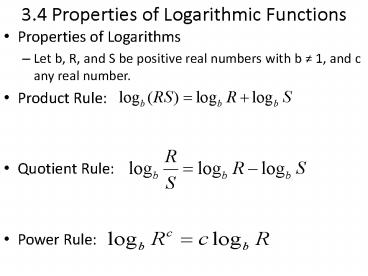3.4 Properties of Logarithmic Functions PowerPoint PPT Presentation
Title: 3.4 Properties of Logarithmic Functions
1
3.4 Properties of Logarithmic Functions
- Properties of Logarithms
- Let b, R, and S be positive real numbers with b ?
1, and c any real number. - Product Rule
- Quotient Rule
- Power Rule
2
Expanding the Logarithm of a Product
- Assuming x and y are positive, use properties of
logarithms to write log (8xy4) as a sum of
logarithms or multiples of logarithms.
3
Expanding the Logarithm of a Quotient
- Assuming x is positive, use properties of
logarithms to write as a sum or
difference of logarithms or multiples of
logarithms.
4
Condensing a Logarithmic Expression
- Assuming x and y are positive, write ln x5 2 ln
(xy) as a single logarithm.
5
Change of Base
- When working with a logarithmic expression with
an undesirable base, it is possible to change the
expression into a quotient of logarithms with a
different base. - Change-of-Base Formula for Logarithms
- For positive real numbers a, b, and x with a ? 1
and b ? 1,
6
Change-of-Base Formula
- The following two forms are useful in evaluating
logarithms and graphing logarithmic functions.
OR
7
Evaluating Logarithms by Changing the Base
- a.)
- b.)
- c.)
8
Graphs of Logarithmic Functions with Base b
- Using the change-of-base formula we can rewrite
any logarithmic function g(x) logbx as
9
Graphing Logarithmic Functions
- Describe how to transform the graph of f(x) ln
x into the graph of the given function. - a.) g(x) log5x
- The graph is obtained by vertically shrinking the
graph by a factor of
10
Graphing Logarithmic Functions
- Describe how to transform the graph of f(x) ln
x into the graph of the given function. - b.) h(x) log1/4x
- The graph is obtained by, in any order, a
reflection across the x-axis and a vertical
shrink by a factor of .
11
Re-expressing Data
- When seeking a model for a set of data it is
often helpful to transform the data by applying a
function to one or both of the variables in the
data set. - Such a transformation of a data set in a
re-expression of the data.
12
More Practice!!!!!
- Homework Textbook p. 317 2 36 even.
PowerShow.com is a leading presentation sharing website. It has millions of presentations already uploaded and available with 1,000s more being uploaded by its users every day. Whatever your area of interest, here you’ll be able to find and view presentations you’ll love and possibly download. And, best of all, it is completely free and easy to use.
You might even have a presentation you’d like to share with others. If so, just upload it to PowerShow.com. We’ll convert it to an HTML5 slideshow that includes all the media types you’ve already added: audio, video, music, pictures, animations and transition effects. Then you can share it with your target audience as well as PowerShow.com’s millions of monthly visitors. And, again, it’s all free.
About the Developers
PowerShow.com is brought to you by CrystalGraphics, the award-winning developer and market-leading publisher of rich-media enhancement products for presentations. Our product offerings include millions of PowerPoint templates, diagrams, animated 3D characters and more.

